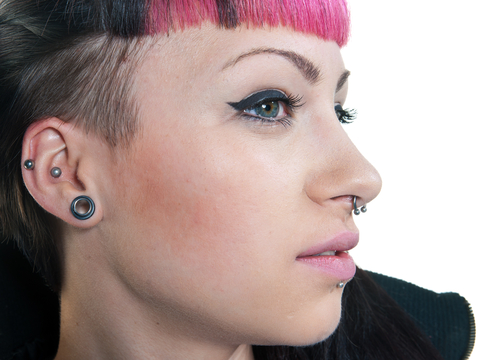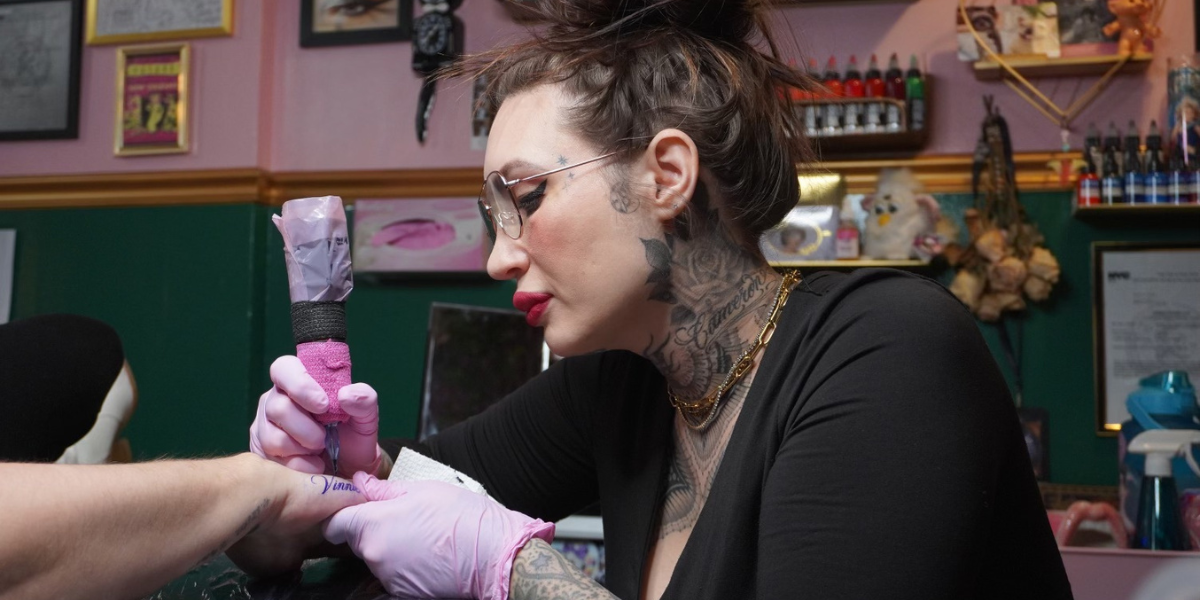Hello, oyster mushrooms! I hear you’re looking into a body modification situation. Maybe you’ve decided it’s time for some scarification or implant horns or a neat tattoo of a heart with the name of the girl you’ve been dating for four whole days inside? I can’t really help you with that stuff because my Jewish mother would actually kill me if I came home with any of those things (I look like a person who’d have a lot of tattoos, but I assure you, I have not a one). But I do have some holes poked in my body! Important disclaimer: I am not a professional body piercer, but I’ve done a lot of research, healed a lot of piercings and battled my fair share of gross keloids. Additionally, I used to date a person who actually was a professional piercer, and they imparted a great deal of their wisdom over the course of many years. What I can do today is give you some tips regarding how to safely acquire and care for a brand new piercing on your body.

Step One: Choosing A Piercer
Maybe you’ve got a friend with a well-boiled safety pin who swears they know what they’re doing, but I’d like to take this opportunity to save you a trip to the ER and a tetanus shot, and encourage you to visit a professional. Personally, I tend to stay away from combination piercing/tattoo parlours because I feel like an establishment that’s 100% dedicated to one or the other is more likely to attract more qualified artists. My go-to spot is Infinite Body Piercing in Philadelphia, who have been responsible for most of the 12 holes in my ears and a lot of my friends and partners’ piercings as well. If you can’t go to Infinite, here are some things to watch out for:
Is the place clean? Are they licensed? Do they have an autoclave?
Avoid any place that uses piercing guns; they can’t be cleaned with autoclaves and put you at way more risk of infection. Autoclaves are the industry standard for sterilizing the jewelry, and if the place doesn’t have one and offers a lame excuse, do yourself a favor and go somewhere else. If you can, read reviews, ask around, and if anything about the place gives you the creeps, trust your instincts before you let a potentially unsafe person shove a piece of metal into your body.
Do they offer a portfolio, and does the work contained within look professional?
Make sure the pictures in the portfolio are of well-healed, well-placed piercings. A buddy of mine went to another place in Philadelphia whose portfolio featured several pictures of pierced dogs, which is a pretty solid dealbreaker (also cruel and gross).
Is the work area sterile?
Is there a separate room where the piercings take place? Your piercer should wash their hands before and definitely be wearing gloves and a surgical mask. The needle should come in a fresh package (not stored in some sort of sterilizing liquid), and the jewelry should be clean.
Step Two: Getting the Piercing
Let’s talk about you!
You should be at least 18 (or with whatever proof of your legal guardian’s consent the place requires).
Any place that is willing to pierce you without IDing you isn’t very credible, and probably isn’t super careful about other important things like cleanliness or safety.
You should be 100% sober.
Alcohol not only clouds your judgement, it also thins your blood, which can be dangerous if you’re getting poked. If you’re taking any medications that might thin your blood (including antibiotics), make sure to let your piercer know.
You should also be absolutely healthy, you shouldn’t be pregnant, and you should have eaten something in the last couple of hours.
If you’re operating on an empty stomach, you could feel faint and/or pass out on the table, and nobody wants that. Also, no reputable piercer will work on someone who’s sick or pregnant, as you run a much higher risk of infection (which could seriously affect the fetus).
It’s totally cool for you to bring your friend or girlfriend or Intern Grace or whoever if you wanna squeeze somebody’s hand.
It’s gonna hurt for a second, and it’s going to feel really weird; there’s no real way around that. Fun fact: the guy who pierced my conch told me that it’d feel “like making out with a unicorn.” He may have lied, but it did make a really satisfying crunch noise.

Step 3: Aftercare
Different kinds of piercings require different kinds of aftercare, and any quality shop should have a brochure of some sort for you to take home and consult. Earlobe, septum and eyebrow piercings take about two months to heal, while ear cartilage, navels, nostrils and nipples can take from six months to a year. Genital piercings vary depending on the location and type of piercing. Basically, what you want to do is keep the piercing clean, keep anything potentially germy away from it, and prevent anything from leaning against the jewelry or adding uncomfortable pressure while it’s healing. For example, with my ear cartilage piercings, it was recommended that I keep my hair tied back (hair carries all sorts of nasty things you don’t want getting inside your piercing), avoid using my phone with that particular ear and take care to sleep on my other side. Some healing piercings will develop some gross crusty stuff or secrete a pale yellowish liquid, and that’s totally normal (it’s lymph, blood plasma and dead cells). Don’t play with the jewelry or spin it around lest something gross should get pulled into the healing wound and trap itself in there.
Get yourself a quality medicated antimicrobial soap, preferably one without added dyes or fragrances – Provon works great, or tea tree oil soap if you’re into natural remedies. You can also use a simple antibacterial soap (again without dyes or fragrances), though the first option is preferable. Wash your hands with the soap first – never touch your piercing with dirty hands – then soak your piercing in water for a minute before using the soap. If you do have crusty discharge on the piercing, use a sterile Q-tip to carefully dislodge it (again – never your fingers). Once that stuff is absolutely removed, you can move the jewelry around through the piercing to work the soap through the piercing, then flush carefully with more warm water. Make sure you wash your piercing once or twice a day, but don’t overdo it; believe it or not, over-washing can also cause infections.
If your shop tries to sell you an “ear piercing wash” that isn’t an antimicrobial soap, don’t buy it. Don’t use neosporin or other creams on your piercing, don’t use rubbing alcohol, and don’t use hydrogen peroxide. Antibacterial creams keep oxygen out of the piercing, which delays healing, creates a breeding ground for infection and makes it tougher to clean, while rubbing alcohol and hydrogen peroxide can be way harsh on the skin around your jewelry.
Sea salt soaks are also great for healing piercings, though there’s really no way to do them without feeling really awkward. Mix 1/4 tsp of non-iodized sea salt into 8 oz (1 cup) of hot water (distilled if possible), and dip your piercing in it in whatever odd position seems necessary. Even a one minute soak once a day is helpful; it helps draw out discharge, improve circulation in the affected area and relieve irritation.
Sometimes piercings get irritated or infected; it’s just a fact of life. You just put a hole in your body on purpose and are asking it to heal around a piece of metal that wasn’t there before, and that can be complicated. Infected piercings feel hot or itchy, secrete green, dark yellow or bloody liquid, and might appear red or swollen. Don’t remove the jewelry – if the wound closes up while still infected, it’ll make it harder to heal. Occasionally, a lump of scar tissue will form around a fresh piercing; this irritation is called a keloid. They can be caused by any number of factors, but all of these things can be easily treated with sea salt soaks and making sure you don’t touch the jewelry with your fingers or put unnecessary pressure on the healing piercing. For keloids, my piercer friend always recommended crushing an aspirin, mixing it with water and rubbing the paste on the affected area. It worked like a charm.

If these symptoms persist or worsen despite the treatments listed above, call your piercer, or better yet, head back to the shop and have an actual professional take a look at it. I’m not a medical doctor, but Agent Scully is.







